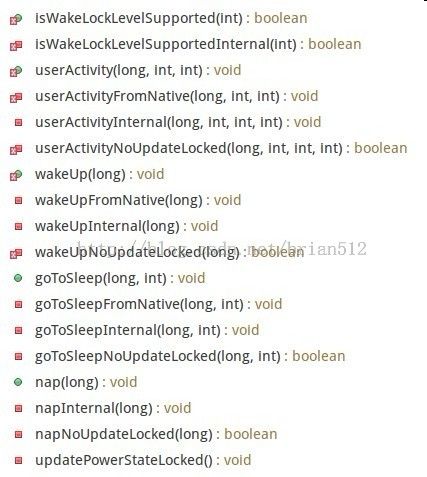Android待机状态更新
Android的待机状态管理由PowerManagerService.java管理
主要的状态更新方法在下面贴出代码, 注释写的很清楚, 第一次看系统源码感觉还比较爽
主要是更新唤醒, 屏幕休眠以及其他的一些状态, 然后系统根据更新的状态进行一些操作, 比如系统睡眠, 进入屏保, 或者电源模式变更等等.
/**
* Updates the global power state based on dirty bits recorded in mDirty.
*
* This is the main function that performs power state transitions.
* We centralize them here so that we can recompute the power state completely
* each time something important changes, and ensure that we do it the same
* way each time. The point is to gather all of the transition logic here.
*/
private void updatePowerStateLocked() {
if (!mSystemReady || mDirty == 0) {
return;
}
if (!Thread.holdsLock(mLock)) {
Slog.wtf(TAG, "Power manager lock was not held when calling updatePowerStateLocked");
}
// Phase 0: Basic state updates.
updateIsPoweredLocked(mDirty);
updateStayOnLocked(mDirty);
// Phase 1: Update wakefulness.
// Loop because the wake lock and user activity computations are influenced
// by changes in wakefulness.
final long now = SystemClock.uptimeMillis();
int dirtyPhase2 = 0;
for (;;) {
int dirtyPhase1 = mDirty;
dirtyPhase2 |= dirtyPhase1;
mDirty = 0;
updateWakeLockSummaryLocked(dirtyPhase1);
updateUserActivitySummaryLocked(now, dirtyPhase1);
if (!updateWakefulnessLocked(dirtyPhase1)) {
break;
}
}
// Phase 2: Update dreams and display power state.
updateDreamLocked(dirtyPhase2);
updateDisplayPowerStateLocked(dirtyPhase2);
// Phase 3: Send notifications, if needed.
if (mDisplayReady) {
sendPendingNotificationsLocked();
}
// Phase 4: Update suspend blocker.
// Because we might release the last suspend blocker here, we need to make sure
// we finished everything else first!
updateSuspendBlockerLocked();
}
调用updatePowerStateLocked()方法的地方有:
可以发现, 基本都是接受到一些系统广播之后进行调用(以handle开头的方法), 以及系统设置后调用(set开头的方法), 来更新电源状态, 还有一些接口回调, 主要是给用户的一些操作

先是public的回调方法, 回调方法把任务传递到内部的private方法(Internal结尾), 还有接收的native方法(Native结尾), 最后都是通过Locked结尾的方法调用updatePowerStateLocked()更新状态.
